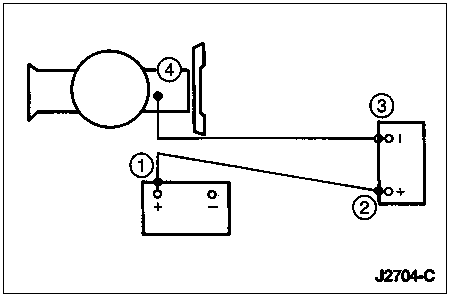Section 03-06: Starting System | 1996 F-Series and Bronco Workshop Manual |
The following instructions for starting the vehicle with jumper cables contain precautions that should be observed to avoid possible injury or damage to the vehicle.
![]() WARNING: HYDROGEN AND OXYGEN GASES ARE PRODUCED DURING NORMAL BATTERY OPERATION. THIS GAS MIXTURE CAN EXPLODE IF FLAMES, SPARKS OR LIGHTED TOBACCO ARE BROUGHT NEAR THE BATTERY. WHEN CHARGING OR USING A BATTERY IN AN ENCLOSED SPACE, ALWAYS PROVIDE VENTILATION AND SHIELD YOUR EYES. DO NOT DISCONNECT THE BATTERY OF THE VEHICLE TO BE STARTED. DISCONNECTING THE BATTERY COULD DAMAGE THE VEHICLE'S ELECTRONIC SYSTEM.
WARNING: HYDROGEN AND OXYGEN GASES ARE PRODUCED DURING NORMAL BATTERY OPERATION. THIS GAS MIXTURE CAN EXPLODE IF FLAMES, SPARKS OR LIGHTED TOBACCO ARE BROUGHT NEAR THE BATTERY. WHEN CHARGING OR USING A BATTERY IN AN ENCLOSED SPACE, ALWAYS PROVIDE VENTILATION AND SHIELD YOUR EYES. DO NOT DISCONNECT THE BATTERY OF THE VEHICLE TO BE STARTED. DISCONNECTING THE BATTERY COULD DAMAGE THE VEHICLE'S ELECTRONIC SYSTEM.
![]() WARNING: TO AVOID ANY POSSIBILITY OF INJURY, USE PARTICULAR CARE WHEN CONNECTING A BOOSTER BATTERY TO A DISCHARGE BATTERY.
WARNING: TO AVOID ANY POSSIBILITY OF INJURY, USE PARTICULAR CARE WHEN CONNECTING A BOOSTER BATTERY TO A DISCHARGE BATTERY.
![]() CAUTION: Headlamp filament failures can occur when vehicle with a dead battery is jump-started with the headlamp switch on.
CAUTION: Headlamp filament failures can occur when vehicle with a dead battery is jump-started with the headlamp switch on.
![]() CAUTION: Use only a 12-volt jumper system. A 12-volt starting motor and other vehicle components can be damaged beyond repair by connecting it to a 24-volt power supply (two 12-volt batteries in series, or a 24-volt motor generator set).
CAUTION: Use only a 12-volt jumper system. A 12-volt starting motor and other vehicle components can be damaged beyond repair by connecting it to a 24-volt power supply (two 12-volt batteries in series, or a 24-volt motor generator set).
NOTE: Battery top has warnings.
To prevent any damage to electrical or lighting components during jump-starting, proceed as follows.
NOTE: Follow procedure in exact sequence.
Position vehicles so jumper cables will reach, being careful that vehicles do not touch.
Turn all lights off before and during jump-starting.
Turn on heater blower motor to remove transient voltage.
Avoid contact with any moving engine parts.
Make connections in numerical order. Disconnect in reverse order.
Connect ends of one cable to the positive (+) terminal of each battery starting with the discharged battery (1 in the following illustration) and going to the booster battery (2 in the following illustration).

![]() WARNING: MAKING THE FINAL CABLE CONNECTION COULD CAUSE AN ELECTRICAL SPARK NEAR THE BATTERY AND COULD CAUSE AN EXPLOSION. REFER TO WARNING AT THE BEGINNING OF THE JUMP-STARTING PROCEDURE.
WARNING: MAKING THE FINAL CABLE CONNECTION COULD CAUSE AN ELECTRICAL SPARK NEAR THE BATTERY AND COULD CAUSE AN EXPLOSION. REFER TO WARNING AT THE BEGINNING OF THE JUMP-STARTING PROCEDURE.
Connect one end of other cable to negative (-) terminal of good battery (3 in the preceding illustration). Connect other end of the same cable to engine block on vehicle being started (4 in the preceding illustration), NOT TO NEGATIVE (-) TERMINAL OF BATTERY.
Make sure jumper cables are not in the way of moving engine parts.
Start engine of vehicle with good battery. Do not crank engine continuously for more than 30 seconds at a time. Allow two minutes for starter motor to cool between cranking. Run engine (6007) at a moderate speed.
Start engine of vehicle with discharged battery. Follow starting instructions in the Owner Guide.
Leave all switches off except heater blower motor. Reduce engine speed to idle on both vehicles to prevent possible damage to vehicle electrical system.
Make certain that engines are at idle speed before disconnecting jumper cables.
Remove cable from engine block first, then other end of negative cable.
Remove ends of positive cable.